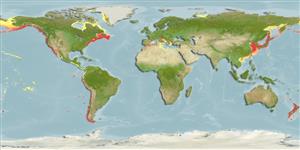|
Sabellida |
Sabellidae
Environment: milieu / climate zone / depth range / distribution range
Ecologia
; intervalo de profundidade 0 - 180 m (Ref. 865). Polar
Cosmopolitan.
Length at first maturity / Tamanho / Peso / Idade
Maturity: Lm ? range ? - ? cm Max length : 9.0 cm TL macho/indeterminado; (Ref. 865)
It is found wedged in fouling organisms on piers and rocks and embedded in soft bottom sediments in subtidal depth up to 180 meters (Ref. 865). A filter feeder (based on the feeding ecology of the family Sabellidae; Ref. 87179).
Life cycle and mating behavior
Maturidade | Reprodução | Desova | Ovos | Fecundidade | Larvas
Members of the class Polychaeta are mostly gonochoric (sexual). Mating: Females produce a pheromone attracting and signalling the males to shed sperm which in turn stimulates females to shed eggs, this behavior is known as swarming. Gametes are spawned through the metanephridia or body wall rupturing (termed as "epitoky", wherein a pelagic, reproductive individual, "epitoke", is formed from a benthic, nonreproductive individual, "atoke"). After fertilization, most eggs become planktonic; although some are retained in the worm tubes or burrowed in jelly masses attached to the tubes (egg brooders). Life Cycle: Eggs develop into trocophore larva, which later metamorph into juvenile stage (body lengthened), and later develop into adults.
Cusson, M., P. Archambault and A. Aitken. 2007. (Ref. 3448)
Categoria na Lista Vermelha da IUCN (Ref. 130435)
Categoria CITES (Ref. 108899)
Not Evaluated
Not Evaluated
Ameaça para o homem
Utilização humana
| FishSource |
Ferramentas
Mais informação
Idade/Tamanho
Crescimento
Comprimento-peso
Comprimento-comprimento
Morfologia
Larvas
Abundância
Fontes da internet
Estimates based on models
Preferred temperature
(Ref.
115969): 2.7 - 21.9, mean 9.5 (based on 1701 cells).
Categoria de preço
Unknown.
